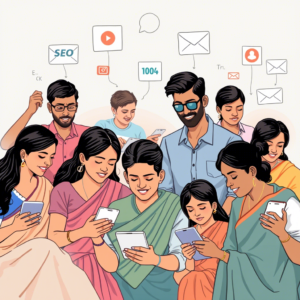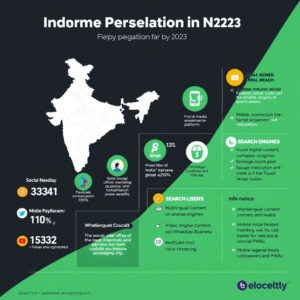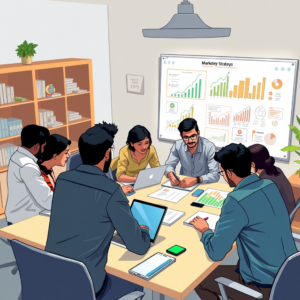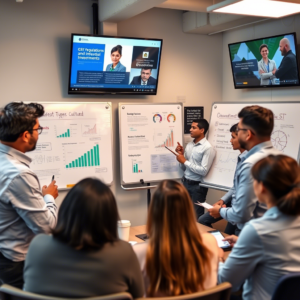
In today’s hyper-connected world, building a strong brand is no longer just about having a memorable logo or catchy tagline. For businesses operating in India’s dynamic and rapidly evolving market, leveraging digital marketing tools has become essential for establishing a robust brand presence. With over 700 million internet users and counting, the Indian digital landscape presents unparalleled opportunities for brands to connect with their target audience in meaningful ways.
Digital marketing tools encompass a wide array of platforms, technologies, and strategies that enable businesses to reach, engage, and convert potential customers more effectively than ever before. From search engine optimization (SEO) and social media marketing to email campaigns and analytics dashboards, these tools provide unprecedented control over how brands present themselves in the digital space. In India, where consumer behavior spans from tech-savvy urban professionals to digitally emerging rural populations, the right combination of digital marketing tools can bridge gaps and create cohesive brand experiences across diverse demographics.
The importance of building a strong brand through digital channels cannot be overstated in India’s competitive market. A well-executed digital marketing strategy not only increases brand visibility but also fosters trust and loyalty among consumers who increasingly rely on online information to make purchasing decisions. Whether you’re a local startup in Pune or an international corporation expanding into Indian markets, understanding and utilizing digital marketing tools effectively can mean the difference between blending into the background noise and standing out as a leader in your industry.
This comprehensive exploration will delve into various digital marketing tools available to businesses in India, examining how each contributes to brand building, customer engagement, and overall market success. We’ll analyze real-world case studies, explore emerging trends, and provide actionable insights tailored specifically to the unique characteristics of India’s digital ecosystem.
Understanding the Digital Marketing Landscape in India

India’s digital marketing ecosystem has undergone remarkable transformation over the past decade, driven by rapid technological advancements and changing consumer behaviors. The country’s internet penetration rate has surged from just 10% in 2010 to over 50% in 2023, creating a massive digital marketplace that spans urban centers and rural communities alike. This growth has been fueled by affordable smartphones, competitive data plans, and government initiatives promoting digital literacy and infrastructure development.
The current state of digital marketing in India reflects this rapid evolution. Social media platforms have become primary communication channels, with over 467 million active social media users as of 2023. Facebook remains the dominant player, followed closely by Instagram and YouTube, while newer platforms like TikTok (after its reinstatement) and ShareChat are gaining significant traction, particularly among younger demographics. WhatsApp Business has emerged as a crucial tool for customer engagement, with over 400 million users in India leveraging the platform for both personal and business communications.
E-commerce has experienced explosive growth, with platforms like Flipkart, Amazon India, and Meesho transforming shopping habits across the country. This shift has created new opportunities for brands to reach consumers directly through targeted advertising, influencer partnerships, and sophisticated remarketing strategies. Meanwhile, the rise of digital payment systems like UPI (Unified Payments Interface) has streamlined transactions, making online purchases more accessible even in remote areas.
Search engine sage patterns in India reveal interesting trends that impact digital marketing strategies. While Google maintains its dominance with over 95% market share, regional language searches have increased dramatically, accounting for nearly 50% of total search queries. This linguistic diversity necessitates multilingual content strategies and localization efforts for brands aiming to maximize their reach. Additionally, voice search has gained significant popularity, with over 27% of Indian internet users regularly using voice assistants, primarily in regional languages.
Video content consumption has skyrocketed, with Indians spending an average of 25 hours per week watching online videos. Platforms like YouTube and Hotstar have become integral to digital marketing strategies, offering brands multiple avenues for storytelling and product demonstrations. Short-form video content, popularized by platforms like Instagram Reels and Josh, has proven particularly effective in capturing attention and driving engagement among younger audiences.
Mobile-first strategies have become paramount in India’s digital marketing landscape. With over 90% of internet users accessing content primarily through mobile devices, brands must ensure their websites, ads, and content are optimized for smaller screens and varying network conditions. Progressive Web Apps (PWAs) and Accelerated Mobile Pages (AMPs) have gained popularity as solutions for delivering fast, seamless mobile experiences.
Data privacy and protection regulations have also begun shaping digital marketing practices in India. The introduction of the Digital Personal Data Protection Bill has prompted brands to adopt more transparent data collection methods and implement robust consent management systems. This regulatory environment emphasizes the need for ethical marketing practices while maintaining personalized customer experiences.
Essential Digital Marketing Tools for Brand Building in India
To navigate India’s complex digital landscape effectively, brands must leverage a comprehensive suite of digital marketing tools tailored to their specific needs and objectives. These tools can be categorized into several key areas, each playing a vital role in building and maintaining a strong brand presence.
Content Management Systems (CMS) form the backbone of any digital marketing strategy. Platforms like WordPress, Wix, and Shopify offer user-friendly interfaces for creating and managing website content. For Indian brands, choosing a CMS that supports multilingual content creation and SEO optimization is crucial. Tools like HubSpot CMS provide integrated marketing automation features, enabling seamless content scheduling, performance tracking, and lead nurturing capabilities.
Social Media Management tools are indispensable for maintaining consistent brand messaging across multiple platforms. Hootsuite, Buffer, and Sprout Social allow brands to schedule posts, monitor engagement, and analyze performance metrics across Facebook, Instagram, Twitter, LinkedIn, and emerging platforms like ShareChat. These tools help streamline social media operations, ensuring timely responses to customer queries and efficient management of paid ad campaigns targeting specific Indian demographics.
Email Marketing platforms remain one of the most effective tools for direct customer communication. Services like Mailchimp, Sendinblue, and Zoho Campaigns offer advanced segmentation features that enable brands to send personalized messages based on user behavior, location, and preferences. For Indian markets, these platforms support regional language emails and integration with popular payment gateways, facilitating seamless transactional communications.
Search Engine Optimization (SEO) tools are critical for improving organic visibility in India’s competitive digital space. SEMrush, Ahrefs, and Moz provide comprehensive keyword research capabilities, backlink analysis, and site audit features. These tools help brands identify high-value keywords in both English and regional languages, optimize website structure for better indexing, and track search engine rankings across different locations in India.
Pay-Per-Click (PPC) Advertising platforms like Google Ads and Facebook Ads Manager offer precise targeting options tailored to Indian audiences. These tools enable brands to create highly customized ad campaigns based on demographics, interests, behaviors, and even offline purchase patterns. Features like Dynamic Search Ads and Lookalike Audiences help maximize ROI while maintaining relevance to specific market segments.
Analytics and Performance Tracking tools provide crucial insights into campaign effectiveness and customer behavior. Google Analytics, coupled with Google Tag Manager, offers detailed reports on website traffic, conversion rates, and user journeys. Heatmapping tools like Hotjar and Crazy Egg help understand how visitors interact with web pages, identifying areas for improvement in user experience. For Indian brands, these tools’ ability to segment data by region and language proves invaluable for optimizing marketing strategies.
Customer Relationship Management (CRM) systems integrate various marketing functions into a unified platform. Salesforce, Zoho CRM, and HubSpot CRM help manage leads, track customer interactions, and automate marketing workflows. These tools facilitate personalized communication at scale, which is particularly important in India’s diverse market where regional preferences and cultural nuances vary significantly.
Video Marketing tools have become increasingly important as video consumption continues to rise in India. Platforms like Vidyard, Wistia, and Vimeo offer features for hosting, analyzing, and optimizing video content. These tools provide detailed analytics on viewer engagement, heatmaps showing watched portions, and integration capabilities with other marketing platforms. For Indian brands, these tools support regional language subtitles and closed captions, enhancing accessibility and engagement.
Influencer Marketing platforms like Influencity, Upfluence, and Heepsy help brands identify and collaborate with relevant influencers across various niches and regions in India. These tools provide insights into influencer performance metrics, audience demographics, and engagement rates, ensuring strategic partnerships that align with brand values and target markets.
Each of these tools plays a complementary role in building a comprehensive digital marketing strategy tailored to India’s unique market dynamics. By integrating these platforms effectively, brands can create cohesive, data-driven marketing campaigns that resonate with diverse Indian audiences while maintaining consistency in brand messaging and experience.
Developing a Comprehensive Digital Marketing Strategy for Indian Markets
Creating an effective digital marketing strategy for India requires a nuanced approach that balances global best practices with local market insights. The first step involves conducting thorough market research to understand regional preferences, cultural nuances, and consumer behavior patterns. Brands should invest in developing detailed buyer personas that reflect India’s diverse demographics, considering factors such as age, income level, education, language proficiency, and digital literacy. This foundational work enables marketers to craft targeted campaigns that resonate with specific audience segments while maintaining overall brand consistency.
Setting clear, measurable objectives forms the cornerstone of any successful digital marketing strategy. For Indian markets, these goals should align with both short-term tactical needs and long-term brand-building aspirations. Common objectives include increasing brand awareness among Tier II and Tier III cities, driving website traffic from mobile devices, generating qualified leads through regional language content, and improving customer retention through personalized communication. Each objective should be accompanied by specific Key Performance Indicators (KPIs) that reflect India’s unique digital landscape, such as regional engagement rates, vernacular content performance, and mobile-specific conversion metrics.
Channel selection plays a critical role in reaching target audiences effectively across India’s varied digital ecosystem. While social media platforms remain essential, brands must carefully choose which channels to prioritize based on their audience’s preferred platforms and content consumption habits. For instance, LinkedIn might be ideal for B2B marketing targeting corporate professionals in metro cities, while ShareChat could prove more effective for reaching younger audiences in semi-urban areas. Similarly, YouTube advertising might work well for product demonstrations, while WhatsApp Business could serve as a powerful tool for customer service and relationship building.
Budget allocation requires careful consideration of India’s cost-effective yet highly competitive digital marketing landscape. Brands should adopt a tiered budgeting approach, allocating resources based on channel effectiveness, audience reach, and expected ROI. Typically, a balanced distribution might include 30-40% for paid advertising (Google Ads, social media ads), 20-30% for content creation and SEO, 15-20% for social media management, 10-15% for email marketing and CRM, and 5-10% for analytics and optimization tools. This distribution allows flexibility to adjust spending based on performance metrics and emerging opportunities.
Integration across digital marketing channels ensures consistent brand messaging and maximizes campaign effectiveness. Brands should develop a centralized content calendar that coordinates activities across all platforms, maintaining thematic consistency while allowing for platform-specific adaptations. For example, a product launch campaign might include teaser posts on Instagram, detailed blog articles on the company website, explainer videos on YouTube, and targeted ads on Facebook – all working together to build anticipation and drive conversions. Automation tools can help synchronize these efforts, ensuring timely execution and proper resource allocation.
Measurement and optimization form an ongoing process in India’s dynamic digital environment. Brands should establish regular review cycles (weekly, monthly, quarterly) to assess campaign performance against set KPIs. Advanced analytics tools can provide granular insights into regional performance, helping identify which strategies work best in different parts of the country. Based on these insights, marketers can refine targeting parameters, adjust content formats, and reallocate budgets to maximize impact. This data-driven approach ensures continuous improvement and helps brands stay ahead in India’s rapidly evolving digital marketplace.

Leveraging Social Media Platforms for Maximum Brand Impact in India
Social media platforms have become indispensable tools for brand building in India, offering unparalleled opportunities to engage with diverse audiences across various demographics. Facebook remains the dominant player, commanding over 320 million active users in India, making it an essential channel for brands targeting broad consumer bases. Its sophisticated advertising platform allows for precise targeting based on location, interests, behaviors, and even offline purchase patterns. Brands can utilize Facebook’s carousel ads to showcase multiple products, collection ads for e-commerce integrations, and lead generation forms to capture potential customer information seamlessly.
Instagram, with its visually-driven format, has emerged as a powerful platform for lifestyle, fashion, and beauty brands in India. The platform’s 210 million users are predominantly younger, urban audiences who respond well to aesthetically pleasing content and influencer collaborations. Features like Instagram Shopping enable direct product tagging and checkout, while Reels offer creative opportunities to reach wider audiences through algorithmic discovery. Brands can leverage Instagram Stories for time-sensitive promotions and use Highlights to maintain permanent access to important content categories.
WhatsApp Business has transformed customer engagement in India, with over 400 million users relying on the platform for both personal and commercial communication. Its catalog feature allows small businesses to showcase products without needing a separate website, while broadcast lists enable efficient mass messaging. The recently introduced WhatsApp Pay facilitates seamless transactions, making it an end-to-end solution for customer acquisition and retention. Brands can use automated chatbots to handle common queries while maintaining human touchpoints for more complex interactions.
YouTube stands out as India’s preferred video platform, with over 460 million users consuming content ranging from educational tutorials to entertainment. The platform’s TrueView ads offer non-intrusive advertising options, while YouTube Shorts competes directly with TikTok for short-form video engagement. Brands can create dedicated channels to host product demonstrations, customer testimonials, and behind-the-scenes content, fostering deeper connections with their audience. The platform’s community tab and live streaming features provide additional avenues for real-time interaction and feedback collection.
LinkedIn, while smaller in user base compared to other platforms, serves as a crucial channel for B2B marketing and professional networking in India. Its 82 million users represent India’s corporate workforce, making it ideal for thought leadership content, recruitment drives, and industry-specific discussions. Sponsored content, InMail campaigns, and targeted display ads help brands reach decision-makers and industry professionals effectively. The platform’s publishing feature enables companies to share long-form articles and establish authority in their respective fields.
Emerging platforms like ShareChat and Josh cater specifically to India’s regional language speakers, offering unique opportunities for hyper-local brand engagement. These platforms support content creation in multiple Indian languages and dialects, helping brands connect with audiences in Tier II and Tier III cities. Their focus on short-form video content and meme culture aligns well with younger demographics’ preferences, while built-in shopping features facilitate direct sales.
Successful brands in India often adopt a multi-platform strategy, tailoring content formats and messaging to suit each platform’s strengths while maintaining consistent brand identity. They leverage cross-promotion opportunities between platforms, using Instagram Stories to tease YouTube video releases or sharing LinkedIn articles on Facebook groups. Regular monitoring of platform-specific analytics helps refine content strategies, ensuring optimal engagement and conversion rates across all channels.

Harnessing Content Marketing to Establish Thought Leadership in India
Content marketing serves as a powerful vehicle for building brand authority and trust in India’s information-hungry market. To create compelling content that resonates with Indian audiences, brands must adopt a strategic approach that combines educational value with cultural relevance. Blog posts addressing local challenges, such as navigating GST regulations or understanding financial investments under Indian laws, position brands as knowledgeable advisors while providing practical solutions to readers’ problems. Infographics summarizing complex data about Indian market trends or consumer behavior help simplify information while encouraging social sharing.
Video content has emerged as a particularly effective medium for engaging Indian audiences, with formats ranging from expert interviews and panel discussions to animated explainers and documentary-style storytelling. Brands can leverage YouTube and other video platforms to host webinars featuring industry leaders, create tutorial series addressing common pain points, and produce behind-the-scenes content showcasing company culture and values. Podcasts, though still growing in popularity, offer unique opportunities to reach busy professionals during commutes or work hours, with topics focusing on industry insights, success stories, and expert interviews.
User-generated content (UGC) plays a crucial role in building authenticity and trust among Indian consumers. Encouraging customers to share their experiences through reviews, testimonials, and social media posts creates a community around the brand while providing valuable social proof. Contests and challenges that invite users to create content related to the brand can generate significant engagement, especially when aligned with cultural events or festivals. For instance, a Diwali-themed photo contest or a Republic Day challenge can spark widespread participation while reinforcing brand association with national celebrations.
Localization remains paramount in content marketing success across India’s diverse linguistic landscape. Brands should invest in creating content in major regional languages like Hindi, Tamil, Bengali, and Marathi, adapting not just the language but also cultural references and examples to resonate with local audiences. This multilingual approach extends beyond written content to include voiceovers for videos, translated infographics, and culturally appropriate imagery. Tools like Google Translate API and DeepL can assist in initial translations, though human editors are essential for maintaining nuance and accuracy.
Interactive content formats, such as quizzes, calculators, and assessment tools, engage users actively while providing personalized value. For example, a financial services brand could create an investment calculator tailored to Indian tax laws, while an education platform might offer career assessment quizzes aligned with Indian job market trends. These interactive elements not only capture user attention but also collect valuable data for future marketing efforts.
Consistency in content delivery builds anticipation and loyalty among Indian audiences. Regular publication schedules, whether daily social media posts, weekly blog updates, or monthly newsletters, help maintain top-of-mind awareness. Content calendars should incorporate seasonal themes, festival tie-ins, and current events relevant to Indian consumers, ensuring timely and contextually appropriate messaging. Repurposing successful content across different formats and platforms maximizes reach while maintaining message consistency.
Measuring content effectiveness requires tracking both quantitative metrics (views, shares, time spent) and qualitative indicators (comments, questions, feedback). Brands should establish clear benchmarks for success and regularly review performance data to refine their content strategy. A/B testing different formats, headlines, and calls-to-action helps identify what resonates best with specific audience segments, enabling continuous optimization of content marketing efforts.
Optimizing Paid Advertising Campaigns for Maximum ROI in India
Paid advertising campaigns in India require meticulous planning and execution to achieve optimal return on investment (ROI) while navigating the country’s unique digital landscape. The foundation of successful paid campaigns lies in precise audience targeting, which begins with demographic segmentation based on age, gender, income levels, and education. However, in India’s diverse market, layering additional targeting parameters such as language preferences, device usage patterns, and regional behaviors significantly enhances campaign effectiveness. For instance, targeting smartphone users in Tier II cities during evening hours when internet usage peaks can yield better engagement rates compared to blanket national campaigns.
Ad creatives must be culturally relevant and linguistically appropriate to resonate with Indian audiences. Visual elements should incorporate colors, symbols, and imagery that align with local preferences, while copy should be crafted in the target audience’s preferred language. Regional language ads often outperform English-only campaigns, particularly in non-metro areas. Brands should also consider incorporating familiar cultural references, festival associations, and local celebrities to increase ad resonance. Dynamic creative optimization (DCO) tools can help test multiple variations of ad elements simultaneously, identifying the most effective combinations for different audience segments.
Budget allocation strategies should account for India’s price-sensitive market and intense competition. Rather than spreading budgets thinly across multiple platforms, brands should focus on channels that demonstrate the highest engagement rates for their specific target audience. Implementing a test-and-scale approach, where initial budgets are allocated to small-scale tests across different platforms and ad formats, helps identify the most cost-effective channels before committing larger investments. Seasonal adjustments are crucial, with increased budgets during festive periods like Diwali or major sales events yielding higher returns.
Performance measurement goes beyond basic metrics like click-through rates (CTR) and cost-per-click (CPC). Brands should track micro-conversions such as newsletter signups, content downloads, and cart additions alongside macro-conversions like purchases. Attribution modeling becomes particularly important in India’s multi-touchpoint consumer journey, where users might interact with ads on multiple devices and platforms before converting. Implementing cross-device tracking and using tools like Google Analytics 4 provides a more comprehensive view of campaign effectiveness.
Optimization techniques should be applied continuously throughout campaign duration. A/B testing different ad elements, adjusting bidding strategies based on performance data, and refining targeting parameters help improve ROI over time. Retargeting campaigns play a crucial role in converting interested prospects who didn’t initially purchase, with sequential messaging strategies guiding users through the sales funnel. Utilizing lookalike audiences based on high-value customers helps expand reach while maintaining targeting precision.
Compliance with local advertising regulations and platform policies ensures smooth campaign execution. Brands must stay updated on guidelines regarding sensitive content, celebrity endorsements, and promotional claims, particularly during election periods or national events. Implementing proper ad verification processes and fraud detection measures protects advertising budgets from wasted spend on invalid traffic or non-compliant placements.
Measuring Success and Adapting Strategies in India’s Dynamic Market
Tracking and measuring digital marketing performance in India requires a comprehensive approach that accounts for the country’s unique market dynamics and consumer behaviors. Brands should establish a robust analytics framework that integrates multiple data sources, including website analytics, social media insights, CRM data, and third-party tools. Customizable dashboards using platforms like Google Data Studio or Tableau enable real-time monitoring of key performance indicators (KPIs) across different regions and audience segments. These dashboards should display metrics such as regional engagement rates, language-specific content performance, mobile vs desktop traffic distribution, and platform-specific ROI.
Adaptation strategies must be agile enough to respond to India’s rapidly changing digital landscape. Regular analysis of competitor activity, emerging platform features, and shifting consumer preferences helps identify opportunities for innovation and optimization. For instance, the sudden popularity of short-form video content on platforms like Josh and Instagram Reels requires brands to quickly adapt their content strategies while maintaining core brand messaging. Implementing a test-and-learn methodology allows brands to experiment with new formats and platforms without risking significant resources.
Success metrics should evolve beyond traditional vanity metrics to focus on business outcomes that matter in India’s context. Customer lifetime value (CLV), regional market penetration rates, and brand recall scores among different demographic groups provide deeper insights into marketing effectiveness. Advanced attribution models help understand the contribution of various touchpoints in the customer journey, particularly important in India’s complex path-to-purchase scenarios. Sentiment analysis tools can gauge brand perception across social media and review platforms, offering early warning signs of potential reputation issues.
Continuous learning and skill development are crucial for maintaining marketing effectiveness in India’s competitive environment. Regular training programs for marketing teams on emerging tools, platform updates, and best practices ensure that brands stay ahead of the curve. Participation in industry forums, webinars, and conferences focused on Indian digital marketing trends helps gather valuable insights and network with peers facing similar challenges. Documenting learnings from past campaigns and creating internal knowledge repositories facilitates institutional learning and prevents repetition of mistakes.
Future-proofing digital marketing strategies requires investing in emerging technologies while maintaining flexibility to pivot when necessary. Artificial intelligence (AI) and machine learning (ML) applications can enhance personalization efforts, predict consumer behavior, and optimize ad spend allocation. Voice search optimization becomes increasingly important as more Indian users adopt voice assistants, particularly in regional languages. Augmented reality (AR) and virtual reality (VR) technologies offer innovative ways to showcase products and services, especially in sectors like real estate, education, and retail.





